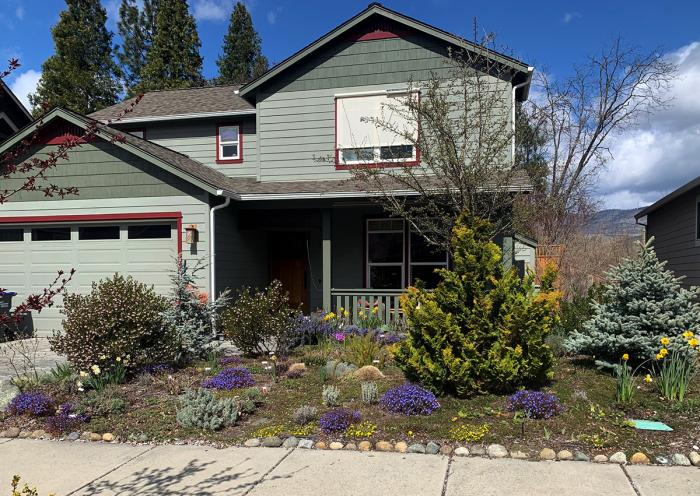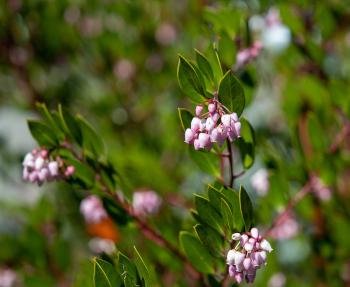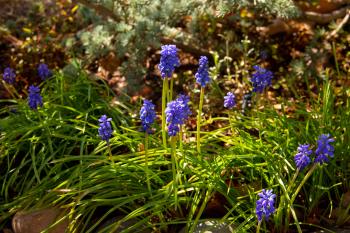Professional Native Landscape Design
Blog Post
Planning your Spring Pollinator Garden
posted: March 1st, 2022

April 1, 2020
Early Spring Pollinator Garden
This Spring is different. There's no denying that! Even if you're isolating and staying at home, we are all still tending our gardens and planning how to make them not only more colorful but more functi*nal for pollinators of all kinds.

Veronica Georgia Blue
Even a simple and small garden can be incredibly satisfying visually if you have designed it with bloom color in mind. I happen to love the combination of yellow and blue or purple that delights me every Spring. The first to come up are the daffodils. Cheerful and smiling, their bright yellow is a great contrast for early-blooming Veronica Georgia Blue.

"Mozart" Rosemary with phlox and daffodils
I can't say enough about how I love rosemary. After the daffodils, this special "Mozart" rosemary from Goodwin Creek Gardens catalog began blooming in late February and is still going strong. It's covered with native and honey bees from sunrise to sunset. It also looks great with the purple phlox snuggled up next to it. Mozart is a wonderful, semi-upright rosemary cultivar with a nice compact stature. The leaves are dark green and the flowers are perhaps the darkest color bluish purple I've ever seen. Nice for small gardens and rockeries. You can use it in cooking as well!

Creeping Potentilla
Last year I added a new ground cover I found in 4" pots. I knew it would complement the blue veronica and echo the yellow daffodils. Creeping potentilla did not disappoint me this year. It forms cheerful little mounds of yellow flowers that stick around for several weeks and holds its foliage throughout the summer. But beware, this plant spreads by underground runners, so it can quickly take over in a garden. I use it as a lawn alternative and I'm going to let it duke it out with the creeping thyme to see which one wins.

Honey bee on rosemary
Around mid-March my lovely Howard McMinn manzanita began putting on a show and competing for "the most bee visits in a day" with the rosemary. The pendulous flower clusters can only disperse their pollen if visited by bees and other pollinators. Ashlanders, consult your list of fire prone plants. I don't think the city wants these in your gardens within 30' of a structure.

Manzanita Howard McMinn is one of the earliest bloomers in my garden
More wonderful blue/purple that I almost take for granted pops up really early to feed the early bees - grape hyacinth. I think I planted a few bulbs 10 years ago, and now they pop up everywhere, thanks to the larger critters who mine the soil beneath my garden. I have them by the hundreds now and after their spring show, I simply cut back the leftover greens.

Grape Hyacynth
Another reliable bloomer that remains semi-evergreen is the Iberis or Candytuft. This is a staple of "landscapes" in office parks and medical centers, but despite its ubiquitous use, it's still a cheerful addition to an early garden with masses of white flowers that last a long time and are very attractive to pollinators.

Iberis - Candytuft
Finishing out the "Full sun" area is my personal favorite for attracting early hummingbirds - that's the Ribes sanguineum - native red flowering currant. The tiny and feisty rufous hummers time their arrival in the Rogue Valley to the exact week that these native shrubs begin to bloom.

Ribes - Red flowering currant
Last year I began to notice that the ribes were also being visited by Orange crowned warblers. These are not feeder birds. They eat insects, berries and obviously also enjoy early nectar from the ribes.

Orange crowned warbler
Here's your list for the nursery. Shooting star is taking orders and will deliver or you can make an appointment to pick up. You will find a retail availability list at their website
Rosemary
Phlox
Veronica
Manzanita
Creeping potentilla
Iberis
Ribes Sanguineum




